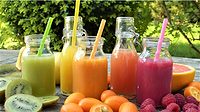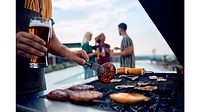Category Focus
Manufacturers adjust sugar, calorie content for lemonades
Lemonade finds its home in non-alcohol, alcohol markets

A concept in numerous video games is when characters reach a checkpoint to save the progress they have made during the game. Should the character lose, they will go back to the checkpoint instead of having to restart at the beginning. Although lemonades have been a staple in many consumer homes, concerns about its sugar content have beverage-makers reverting to a checkpoint where they are maintaining the goodwill with consumers but altering their formulation strategy.
“Consumer avoidance of sugar-heavy beverages due to their perceived health detriments has posed an increasing threat to juice producers, including lemonade beverages,” says Dmitry Diment, senior industry research analyst at IBISWorld, New York. “A 2015 study published in the Nutrition Journal found that, on average, fruit juice contains 45.5 grams of fructose concentrate per liter, which is slightly less than the 50 grams of fructose contained in a liter of soda.
“A May 2019 publication by the American Medical Association reported similar health consequences when consuming 100% fruit juice as other sugary beverages,” he continues. “As consumers have become more health conscious, they have shied away from sugary lemonade drinks.”
Diment notes that beverage-makers in response are adapting their formulations to support these health conscious goals.
“Although lemonade contains natural and added sugars, producers have rebranded and reformulated goods,” he says. “Producers have successfully commercialized the benefits of fruit as an essential part of a healthy diet.”
Laura Harper, marketing associate at Imbibe, Niles, Ill., also highlights the impact that sugar reduction and overall health-and-wellness trends has had on the lemonades segment.
“With health and wellness being a top priority for many Americans, especially coming out of the pandemic, the lemonade market is not exempt from innovation to remain competitive and relevant,” Harper says. “According to a 2022 U.S. survey by Statista, 59% of participants (U.S. adults) said they were trying to limit sugars in their diet.
“Meanwhile, food and beverage companies are waiting for the FDA to rule on their Healthy proposal, which will regulate when and what healthy claims can be made on packaging based on several factors including the amount of sugar,” she continues. “This means many companies will be turning to sugar substitutes following those that have already prioritized low and no sugar formulations, like Swoon, Uncle Matt’s Organic no sugar added Classic Lemonade and Strawberry Lemonade (which uses stevia), Minute Maid Zero Sugar, and Poppilu (acquired by Juicy Juice parent company in 2022).”
Yet, sugar reduction is not the only way that manufacturers are changing the course for the lemonade market. The addition of functional attributes also is proliferating throughout lemonades.
“Because of the wholesomeness and nostalgia associated with lemonade, it’s a popular flavor in products that may or may not actually have juice in them,” Harper explains. “Even so, there are lemonade-type products that boast adaptogens, antioxidants, electrolytes, BCAAs, vitamins, nootropics, and probiotics, such as newly released Space Tea Iced Tea Lemonade with adaptogenic mushrooms and Smoothie King’s 2023 Summer X-Treme Watermelon Lemonade Smoothie, which contains coconut water (naturally hydrating) and dairy whey (for a punch of protein).
Stepping into alcohol
Although lemonade has been known as a liquid refreshment beverage, the market also is seeing lemonade become a major player on the beverage alcohol side.
“While traditional brands like Mike’s Hard Lemonade and Smirnoff Ice comprised almost all of [ready-to-drink] (RTD) mixed spirits’ sales a few years ago, new and attractive brands like White Claw and Truly have climbed to the top of the charts,” IBISWorld’s Diment says. “Here too lemonade flavor profiles have benefited from the perceived health benefits of fruit. Producers have expanded product lineups to include low-calorie options, where lemonade flavor profiles feature prominently.”
Diment further emphasizes the growing influence that sugar and calorie reduction is having on lemonade-associated beverage alcohol products.
“The shift to lower calorie variants will ultimately be the primary driving force for lemonade-flavored drinks,” he says. “Indicative of this, Mike’s Hard Lemonade initially appealed to young drinkers with their sweet flavors and captured a large share of the RTD cocktails market. But coming in at 220 calories and 32 grams of sugar, Mike’s Hard Lemonade had been isolating its sales away from the growing number of individuals who are placing greater emphasis on living a healthy lifestyle. Brands like Mike’s Hard Lemonade have reformulated their strategies to appeal to these consumers by introducing RTD cocktails that are both refreshing and have reduced amounts of sugar and calories.”

Imbibe’s Harper adds that the integration of lemonade into beverage alcohol is not a new concept, but instead has been re-centered as vanguard brands have embraced this flavor profile.
“Lemonade has been popular in alcohol for decades ― think ’70s lemon drop martini, ’90s Mike’s Hard Lemonade, and ’00s Leinenkugel’s Summer Shandy ― and has flourished with the RTD cocktail craze, which was globally valued at $782.8 million in 2021 and is expected to expand at a compound annual growth rate (CAGR) of 13.4% from 2022 to 2030, according to Grand View Research,” Harper says. “Lemonade cocktails, shandies, and radlers have been around for over a century.
“Truly and White Claw Lemonade Seltzers have helped re-center a conversation around alcoholic lemonades, and we wouldn’t be surprised if more lemonade inspired hard seltzers make it to market in the next five years in an attempt to grab market share,” she continues. “Though innovations continue with novel categories and flavor combinations, lemonade in alcohol is certainly a sustainable staple in alcoholic beverages.”

Smirnoff Vodka, a brand of New York-based Diageo North America, recently extended its lemonade offerings with the release of Blue Raspberry Lemonade. With a burst of tart and sweet and the nostalgic taste of blue raspberry, Smirnoff Blue Raspberry Lemonade contains a 30% ABV. Also available this summer is Smirnoff ICE Blue Raspberry Lemonade, the brand’s latest premium malt beverage containing a 4.5% ABV.
With how engrained lemonade is with consumers, IBISWorld’s Diment anticipates that alcohol versions of lemonades will continues to proliferate the market, but with a more conscious approach to sugar and calories.
“The previous success of lemonade-flavored beverages is indicative of its staying profile. Lemonade is, after all, as American as apple pie,” he says. “The key for lemonade cocktail drinks will reflect the broader RTD cocktail market. With consumers on the hunt for tasty, low-calorie, and reduced-sugar options, producers can be expected to play up to the fruit drinks’ perceived nutritional benefits while actually rolling out products with slimmed down calorie counts.”
Looking for a reprint of this article?
From high-res PDFs to custom plaques, order your copy today!







